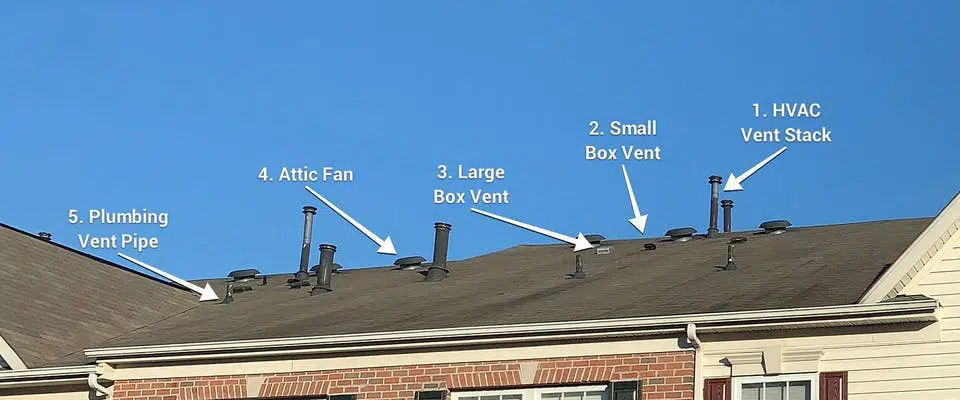What Are The Different Pipes On My Roof?
Although they might seem to blend in with the rest of a roof untrained eye, the different roof pipes, vents, and accessories on a roof are vital in ensuring a home’s safety, comfort, and functionality. A roof is a complex system, outfitted with various pipes, vents, and other elements that each serve a specific purpose. Let’s breakdown the different pipes and accessories that you see in this picture and might be on your own roof.Roof Pipes & Vent Systems
Roof vents, as their name suggests, are designed to vent out the hot, humid air from your attic or roof space. They are key to maintaining proper attic ventilation, helping to control temperature and moisture levels, thus preventing issues like mold growth or structural damage due to ice dams. You might see different types of roof vents like box vents, soffit, or ridge vents, each with a unique design but sharing the same purpose.1. HVAC Vent Stack
These types of vents are part of your home’s HVAC (Heating, Ventilation, and Air Conditioning) system and are connected to the fuel-burning appliances in your home. For example, a furnace, boiler, or water heater. These come with specifically designed flashing kits to seal the connection between the pipe and the roof.2. Small Box Vent
Smaller box vents are used for either your bathroom vent fan or a clothes dryer. If your bathroom fan doesn’t vent outside the roof, it could result in a condensation leak. These vents allow moisture and heat from these appliances to escape safely from your home, preventing condensation build-up and potential mold growth. Just like the larger roof vents, these also need to be regularly checked and the protective vent screen should be cleaned to ensure they are functioning correctly.3. Large Box Vent
Typically, 12”x12” box vents are used to vent the attic space of hot air and condensation. Large box vents are a simple but effective solution to promote air circulation in your home, contributing to the overall health of your roof and your home’s energy efficiency. This passive ventilation method can help to regulate attic temperatures and prevent the buildup of moisture.4. Attic Fan
The attic fans also work in conjunction with your ventilation system to pull the hot air and condensation out of your attic. Attic fans can help prolong the lifespan of your roof, while also reducing the strain on your air conditioning system and helping to keep your energy bills down.5. Plumbing Vents & Pipes
Plumbing vent pipes, often recognizable as vertical pipes standing 2’ up from the roof line, serve a critical role in your home’s plumbing system. They allow air to enter the plumbing system to maintain proper pressure and ensure wastewater flows out smoothly. Also, these pipes vent sewer gases outdoors, keeping your home odor-free. They require a specific type of flashing to cover the transition between the pipe and the roof. You may hear these plumbing vent pipes described as: pipe collar flashing, pipe jack, and pipe boot. All of which are referring to the exact same thing.6. High-Efficiency Furnace System
The intake and exhaust for a high-efficiency furnace. The intake requires a gooseneck to prevent moisture from entering the pipe. The taller straight pipe is for the exhaust.Other Pipes & Accessories That May Be On Your Roof
- Chimney: The stereotypical vertical pipe or attached structure that provides ventilation for smoke and gases from fireplaces, stoves, or furnaces.
- Skylights & Sun Tunnels: Transparent or translucent windows installed on the roof to allow natural light into the interior space.
- Solar Panels: These panels convert sunlight into electricity and are increasingly common on roofs for renewable energy generation.
- TV or Satellite Dish Antennas: These devices are installed on roofs to receive television or satellite signals.
- Gutters & Downspouts: These are not technically on the roof itself but are often attached to the roof’s edge to collect rainwater and direct it away from the building’s foundation.
The Importance of Everything On Your Roof
Maintaining the various types of roof pipes and vents is essential for the safety and longevity of your home. Failure to do so can lead to a myriad of problems, from water damage to potential health hazards. It’s advisable to have your roof inspected at least once a year, or more often if you’ve noticed issues like dampness, odors, or frequent plumbing problems. If you live in Maryland, contact RoofPRO today to schedule an appointment with one of our roofing experts.Discover How Roof Penetrations Impact Your Home’s Performance
You identified the pipes on your roof and now it’s time to understand how they influence roof performance and ventilation. Start with Parts of a Roof System to see how all components—from decking to shingles to vents—interact. Then read about difference between Gable, Soffit & Ridge Vent and compare in detail via Ridge Vents vs Attic Fans. Don’t ignore the pairing of intake and exhaust in Soffit & Ridge Vents.
Penetrations are one of the most common leak points. Our article What You Should Know About Pipes on Your Roof walks you through inspection and maintenance steps. For a deeper dive into edge systems and how the outermost layers protect your roof, explore Fascia Repair—because soffits, fascia, and vent flashings often work together to keep water out.
If you’re concerned about roof pipes, flashing, or ventilation issues, Reach out to our Maryland roofing team today and we’ll perform a full inspection and recommend solutions tailored to your home.




